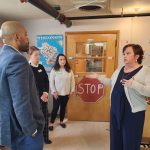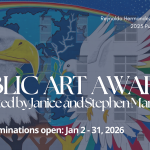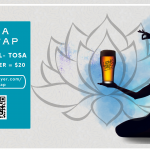RedLine on the front line
Right now, it’s a non-descript 14,400 sq. ft. two-story warehouse abutting a sidewalk just north of the Park East corridor near downtown Milwaukee. There are quite a few similar aging buildings curving up the gentle slope to a downtrodden section of the Brewers Hill neighborhood. But currently, this nearly gutted structure at 1422 N. 4th Street is likely the only one with a red rose petal trail bisecting the dusty wooden main floor – daring you to step over it.
It is Valentine’s Day morning. Arts advocate Lori Bauman and well-known art educator Steve Vande Zande stand bathed in sunlight before a small crowd. They introduce a space that may become the city’s next arts “urban laboratory” and educational center. The facility optimally will provide multi-layered services to its artists, including studio workspaces, shared conversations and opportunities for outreach. The idea, according to the mission statement, is to “nourish the individual practice of contemporary art and to stimulate the creative potential of the local community to which we are all linked.”
It’s a concept that isn’t completely novel to Milwaukee. Forms of collaborative programming, studio space, on-site education and community projects have existed before in some way with entities such as the Milwaukee Art Museum’s support groups, Bucketworks (which is nearby), Hide House, Milwaukee Arts Resource Network, Kunzelmann-Esser Lofts, Riverwest Artists Association and so on.
“What makes this special,” says Bauman at the microphone, “is the way all [our] programs that are under one roof will work together and support each other.”
One of Bauman’s specific objectives, as she explains later, is to encourage artists into explore different forms such as video – and to see the way pop culture and media shape identities.
Hartford School’s art specialist Vande Zande has broader goals for the space and doesn’t know what his exact role will be yet, stating: “Life has many paths.”
While he acknowledges the tough economy and the need to pool all available resources (“we’re working our tails off to get the money to make this”), he believes that the strength in making Redline happen is people’s need to get excited about something.
They have a long road ahead if their affiliate center wants to catch up to the buzz Redline founder Laura Merage received with the beautiful and ambitious 20,000 sq ft. space in Denver, Colorado. That location already rolled out its first show in late October of last year. Merage, who is a photographer, sculptor, and now philanthropist after marriage to husband David, sits on the board of the directors for the Milwaukee group and Redline Denver is now the model to learn from and follow.
Just a few days prior to Milwaukee’s open house in February, an unnamed set of backers (made up partially of MIAD graduates, Redline partners Kari Couture and Kim Weiss, plus other business partners) from a real estate holding company called Wisconsin Arts Lab, LLC bought the building for $480,000 and incredibly donated the entire lease to the burgeoning incubator.
Architect Bruce Wydeven, whose artist wife may have allowed him a unique understanding of what was needed in developing a space, has made grand designs which will create spaces on three levels including a centered exhibition space surrounded ongoing work. ASI General, Inc. construction out of Waukesha has slated the renovation work to be finished just six months from now.
Julie Anderson, a registered nurse and avid photographer from Mequon, jumped in some time ago to help Bauman and Vande Zande. Anderson helped secure a prince of a place from a field of frogs, figured out logistics, and has signed on as a board member as well.
“Initially, it’ll be paid for and subsidized by a few individuals,” Anderson tells me. “The goal is to eventually [have Redline] fund itself through grants and education programs.”
Anderson was most interested in the idea of interaction and atmosphere between the artist and community. She is drawn by the notion of a whole package rather than “if we were just to open another studio space with a bunch of artists.”
It seems like everyone rolled up their sleeves at once to make this brick and mortar structure happen, but in actuality it has been a five-year struggle from concept to reality.
The name of the organization itself originated partially as a joke many years ago as Vande Zande and Bauman shared a fondness for the “red line” subway train service out of Manhattan in New York when they both attended school. Later “Redline” would become a term to its initiators of defying artists to step over an imaginary boundary that would take them into a “comfort zone” of exploration and advocacy in art.
According to Vande Zande, the fostering arts conversation with himself and Bauman began over coffee, on the phone, and in various settings after meeting as colleagues working for the MAM’s educational program. During this time, Bauman met Merage through New York University’s travel abroad program and she entered the conversation. When the concept reached a head and became reality, they decided to operate under one name.
How successful will Redline be? Although they are four blocks away from Roosevelt Middle School of Art and a short bus ride from all the other arts schools, Milwaukee’s involvement and acceptance (and purchasing power) of the arts has always fluctuated. DIY-style work spaces have come and gone over the past ten years, and while Gallery Night has flourished, it is often accepted by emerging artists participating that it’s one thing to get noticed and quite another to have patrons.
But Milwaukee has also presented itself finally as a city that accepts the diversity in its voices and puts the output on display. Galleries and museums are showcasing more local art, and the internet has progressively found ways to promote it. However, typing to fellow artists on a keyboard or meeting once a month in a subgroup doesn’t have the same tactile sense that an open group with a headquarters might feel like.
For more images from the Feb. 14, 2009 open house for Redline Milwaukee, watch the slideshow HERE






















